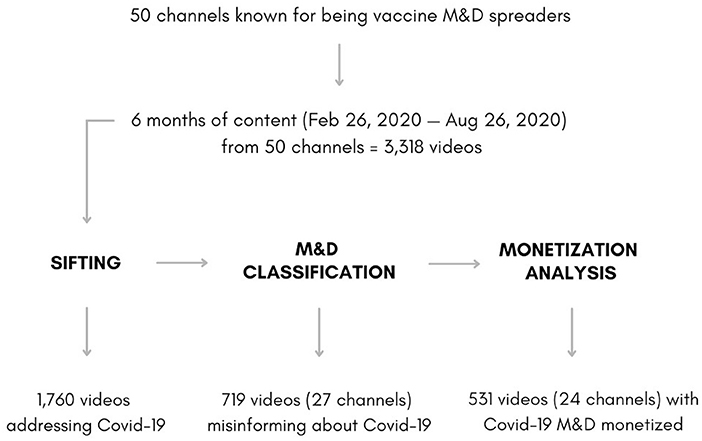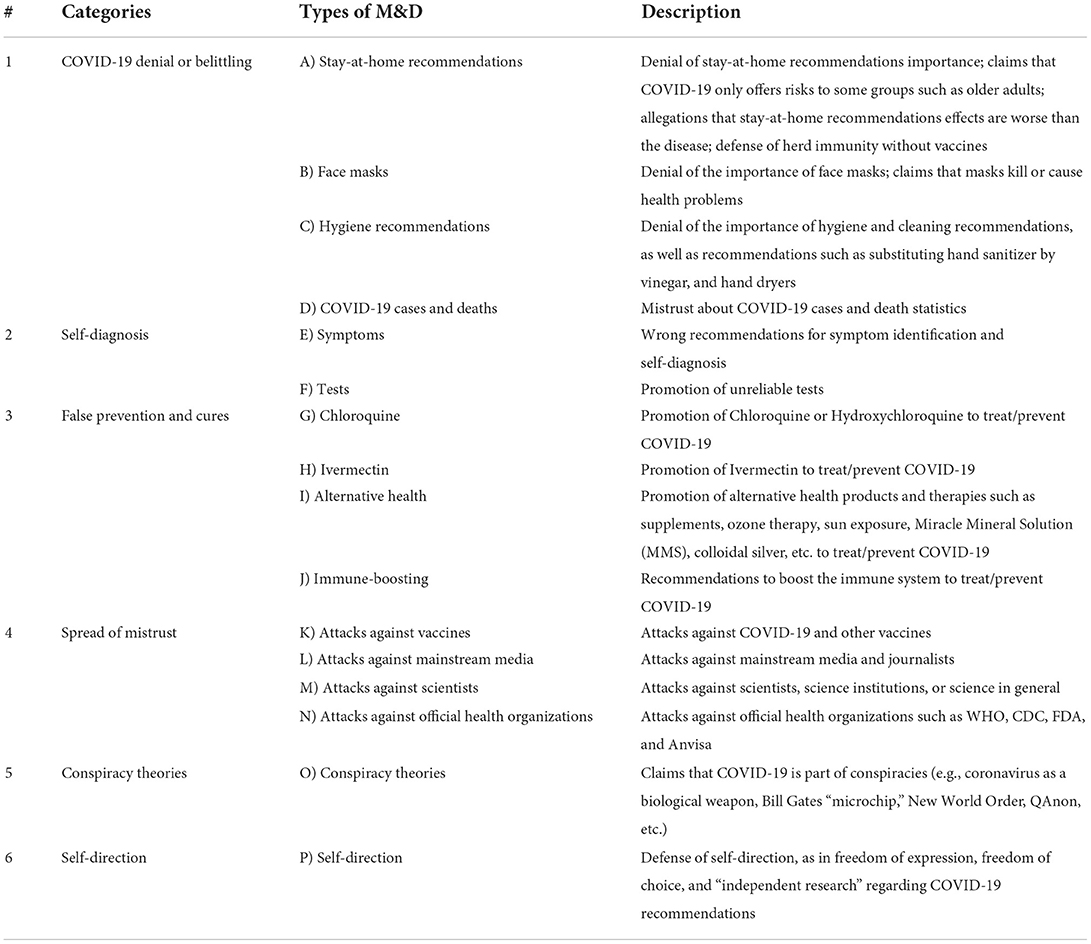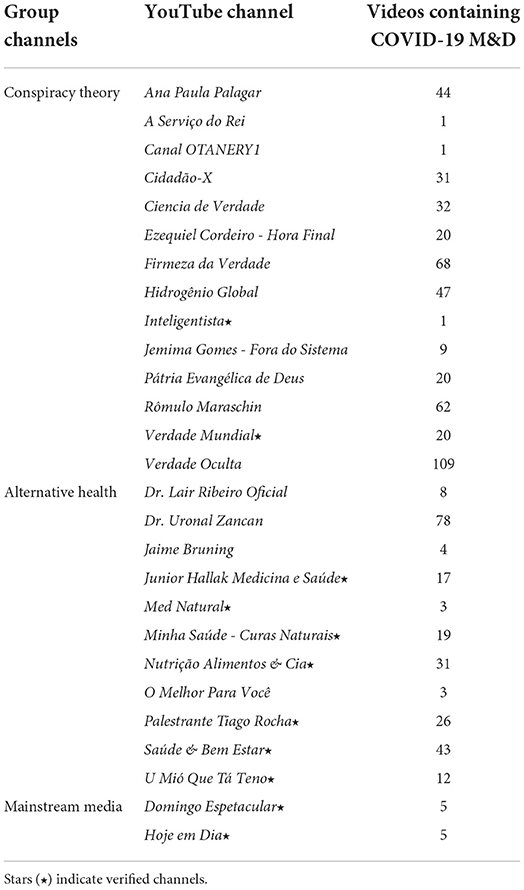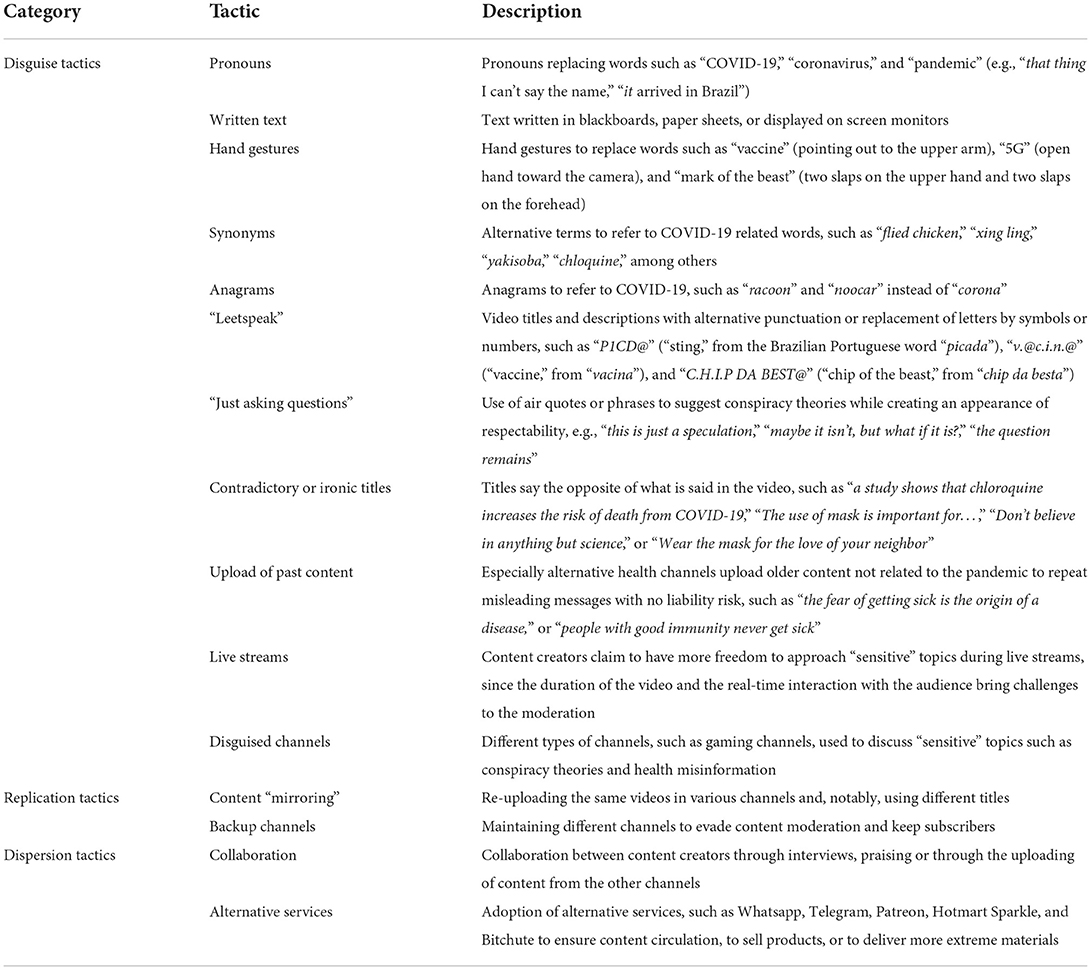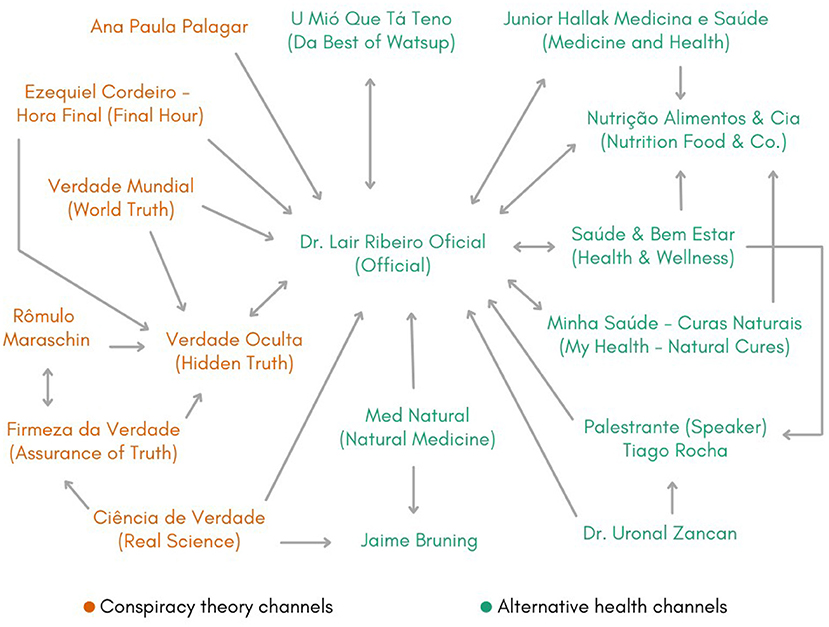- 1Department of Science and Technology Policy, Institute of Geosciences, State University of Campinas, Campinas, Brazil
- 2Institute for Globally Distributed Open Research and Education (IGDORE), Stockholm, Sweden
- 3Berkeley Institute for Data Science, University of California, Berkeley, Berkeley, CA, United States
COVID-19 misinformation became accessible and profitable through social media platforms, such as YouTube. Here we investigate if Brazilian YouTube channels previously identified as vaccine misinformation spreaders would also misinform their audience about COVID-19. Our analysis sample consists of 6 months of content (3,318 videos) from 50 Brazilian YouTube channels. We establish a protocol to classify the types of COVID-19 misinformation spread by the content creators, describing how the channels evade content moderation—disguising, replicating, and dispersing misinformation—and what tactics the content creators use to profit. Our analysis shows that these channels exploited COVID-19 misinformation to promote themselves, profiting in the process.
Introduction
Since the COVID-19 pandemic was declared a global health emergency by the World Health Organization (WHO) in January 2020, the disease infected more than 585 million people worldwide (Pettersson et al., 2022). Official health organizations also manifested concern about the “infodemic,” a concept adopted by the World Health Organization (2021) to refer to the overabundance of information—and particularly misinformation and disinformation (M&D)—about the pandemic.
Misinformation is defined as the false information disseminated without the intent to mislead, while disinformation is the false information deliberately distributed to deceive (Lewandowsky et al., 2020). M&D can damage society in many ways (Lewandowsky et al., 2013; Jolley and Douglas, 2014). People who believe in conspiracy theories about COVID-19 are less likely to follow government guidelines regarding the pandemic, to take coronavirus tests, or to be vaccinated (Freeman et al., 2020).
Platforms updated their policies in response to this issue, banning misleading advertisements, removing content and accounts that violated rules, providing panels or pop-up notifications with certified information, and redirecting users to authoritative content (Bailey et al., 2020). In April 2020, YouTube stated that it would not allow COVID-19 information contradicting health authorities (Wojcicki, 2020), and 5 months later, it expanded this policy to remove videos containing misleading information about COVID-19 vaccines (YouTube, 2020; Graham, 2021).
YouTube was a source of deceptive content in other outbreaks, such as H1N1 (Pandey et al., 2010), Ebola (Pathak et al., 2015), and Zika (Bora et al., 2018). Therefore, several researchers are studying COVID-19 M&D on the platform. Li et al. (2020) found misleading information in more than 25% of the most viewed videos about COVID-19. Studies also registered COVID-19 M&D slipping through YouTube in languages other than English, such as Arabic, Bengali, Dutch, Hindi, Nigerian Pidgin, Spanish, and Korean (Dutta et al., 2020; Hernández-García and Giménez-Júlvez, 2020; Moon and Lee, 2020). Similarly, Machado et al. (2020) analyzed COVID-19 M&D networks in Brazilian Portuguese, with channels spreading conspiracy theories about the pandemic and offering alternative health services to prevent or treat COVID-19.
In this study, we adopted a case study approach to investigate if Brazilian YouTube channels previously identified as vaccine M&D spreaders (Avaaz SBIm, 2019; Tokojima Machado et al., 2020) would also misinform the audience about COVID-19. We developed a protocol, based on previous research, to identify COVID-19 M&D in our sample; applying this protocol, we identified the types of COVID-19 M&D disseminated by the channels besides what tactics they use to evade content moderation and profit from COVID-19 M&D.
Materials and methods
Data collection
Our sample consisted of videos from 50 Brazilian YouTube channels previously identified as vaccine M&D spreaders (Avaaz SBIm, 2019; Tokojima Machado et al., 2020). Using a case study approach, we considered all 3,318 videos posted in an interval of 6 months since the first COVID-19 case registered in Brazil (Paraguassu, 2020), from February 26 to August 26, 2020. We obtained the list of videos and their metadata using the collection of tools YouTube Data Tools (Rieder, 2015) on September 5, 2020. Using a snowball approach, we also visited the channels to gather data about the dynamics of collaboration between the content creators. We aim to understand: 1. if YouTube channels that spread vaccine M&D also misinform the audience about the COVID-19 pandemic; 2. what are the types of COVID-19 M&D spread by the channels; 3. how the channels evade content moderation, and 4. what tactics the content creators use to profit.
Analysis
The 3,318 videos posted in an interval of six months since the first COVID-19 case registered in Brazil were watched by two of the authors between October 20 and November 20, 2020, and only those that mentioned COVID-19 were considered (“sifting” method, Figure 1). This way, we obtained 1,760 videos. From these, fifty-two videos were either unavailable due to removals performed by YouTube or had their access restricted by the creators, therefore we could not access them.
To specify what videos in our sample contained COVID-19 M&D, they were analyzed according to six main M&D categories created for this study. The classification protocol we used was based on recent studies on M&D (Brennen et al., 2020; D'Souza et al., 2020; Dutta et al., 2020; Hernández-García and Giménez-Júlvez, 2020; Koltai, 2020; Li et al., 2020; Machado et al., 2020; Marchal and Au, 2020; Moon and Lee, 2020). Each category consists of the main types of COVID-19 M&D (Table 1) according to the World Health Organization (WHO) guidelines. We chose to create a protocol tailored for these specific types of M&D instead of adopting scoring tools such as DISCERN (Charnock et al., 1999) or JAMA Benchmark Criteria (Silberg, 1997), since they may be inadequate to represent the dynamics and the complexity of the dissemination of M&D on YouTube channels (Marwah et al., 2021).
Since identifying misinformation can be a challenge in some contexts, we based ourselves on the approach described by Vraga and Bode (2020, p. 3): an “information considered incorrect based on the best available evidence from relevant experts at the time” can be considered misinformation. This way, we also used the WHO guidelines to treat the evolution of evidence over time. We considered the publication date of each video while performing their classification. We evaluated the inter/intra-observer agreement in our classification using a random sample of 100 videos, resulting in a Cohen's kappa coefficient (Cohen, 1960) of 72.96% of agreement between the video reviewers. All 16 types of M&D presented in this study (Table 1) were used while calculating kappa; we considered not only if a video contains misinformation or not, but what kind of misinformation is presented in each one. Therefore, perfect agreement between the specialists becomes somewhat difficult.
Both authors who watched the videos performed this classification step between January and March, 2021. From our classification, we obtained 719 videos containing some type of COVID-19 M&D. We also analyzed these videos to understand how the channels evade content moderation while misinforming the audience: we registered each tactic found during the classification process, and then used this data to evaluate the video contents and their metadata, such as titles and descriptions. To identify what strategies the channels used to monetize content, all videos were watched again, now using the Firefox browser in private mode to minimize YouTube's ad personalization. We used screenshots to register the brands advertising on each video. The reviewers also documented other YouTube Partner Program (YPP) features—Channel memberships, Merch shelf, Super Chat, Super Stickers, and Super Thanks—and alternative forms of monetization, such as independent ads, links for crowdfunding pages, and donation requests. To identify the alternative forms of monetization, we analyzed the video contents and their descriptions: we registered all products and services the content creators advertised, and also when they asked for donations. Then, we visited the links posted in the video descriptions to understand if they were crowdfunding pages or e-commerce websites. The authors performing the classification also analyzed the channel monetization between April and August, 2021. Videos containing COVID-19 M&D in our sample were visited again on October 13, 2021 and on May 18, 2022, to check if they were still in the YPP after the platform updated its Community Guidelines to address COVID-19 M&D, in April (Wojcicki, 2020; YouTube Help, 2021a), and October, 2020 (YouTube, 2020; Graham, 2021).
Results
YouTube channels that spread vaccine M&D also misinform the audience on the COVID-19 pandemic
We found out that 719 videos, 41% of our sample addressing the COVID-19 pandemic, misinformed the audience. These videos were created by 27 channels, more than half of the ones we analyzed (Table 2). In October 2021, 11 of them were verified by YouTube. They are divided into three groups: 14 are conspiracy theory channels that discuss health-related topics; 11 are alternative health channels that foster different conspiracy theories when convenient for their interests; and two are mainstream media channels that republish content from Record TV, one of the largest Brazilian TV channels and an ally of President Bolsonaro during the COVID-19 pandemic (RSF, 2020; Mazieiro, 2021).
The channels spread 14 different types of COVID-19 M&D in the period of our analysis. The types of M&D we identified most frequently in our sample were COVID-19 conspiracy theories (466 videos) and defense of self-direction regarding COVID-19 (415 videos). Denial of the importance of stay-at-home recommendations, attacks against mainstream media, and promotion of alternative health products were found in more than 200 videos each (262, 256, and 232 videos, respectively). Lastly, we found recommendations to boost the immune system as a COVID-19 prevention or treatment (195 videos), COVID-19 vaccine M&D (130 videos), attacks against scientists (109 videos), denial of the importance of face masks (91 videos), attacks against official health organizations (91 videos), promotion of Hydroxychloroquine (67 videos), mistrust about COVID-19 cases and death statistics (56 videos), denial of the importance of hygiene recommendations (19 videos), and promotion of Ivermectin as a COVID-19 prevention or treatment (19 videos).
Besides COVID-19, YouTube allowed conspiracy theory and alternative health channels to organize, reach and loyalize audiences, and to profit from often harmful content for years (Briones et al., 2012; Venkatraman et al., 2015; Lewis, 2018; Allgaier, 2019; Tokojima Machado et al., 2020; Brotas et al., 2021). The channel Verdade Oculta, for instance, was created in 2009, and since its first videos, it spreads conspiracy theories about vaccines in general, the mainstream media, and official health organizations (Figure 2).
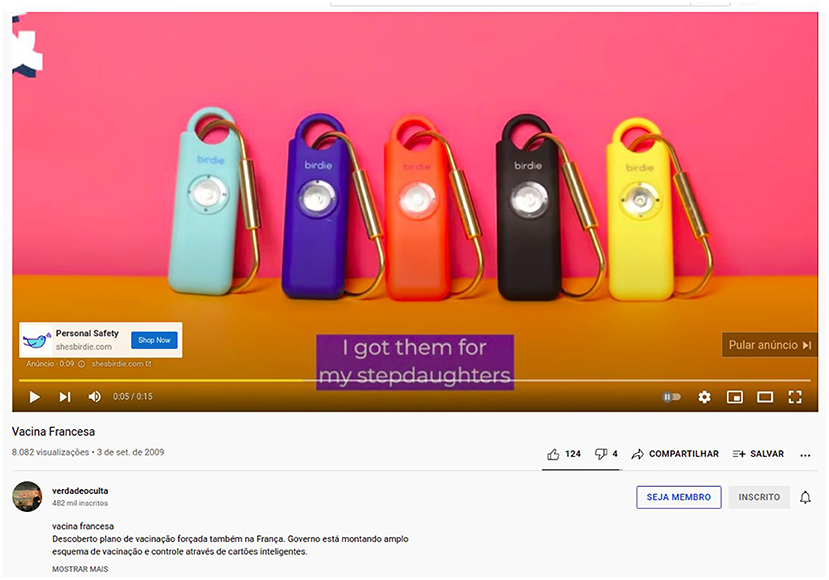
Figure 2. Screenshot of one of the first videos from the channel Verdade Oculta published in 2009 and still monetized by YouTube. The video says that the 2009 H1N1 pandemic was a conspiracy to set a vaccine mandate and establish domination.
Eleven years later, the channel warned it's more than 480 thousand subscribers that the COVID-19 pandemic was part of the “New World Order” plans (Stewart, 2002), and that the only way to survive would be to flee to isolated parts of the country. The content creator also promoted a project called “Singles on the run” to reunite “awakened” couples, and offered the opportunity to buy an “ideal” survival place in the middle of the Amazon, near his property. According to him, when moving to that region, the audience would step out of the system, have “wide freedom,” and would not need to accept the COVID-19 vaccination or other “forms of control.” The campaign expanded the conspiracy thinking community offline, and in February 2021, it had more than 250 families living in a “secret” place on the Amazon waiting for the end of the world. The content creator continues using the channel to sell land while profiting from the YPP (Figure 3).
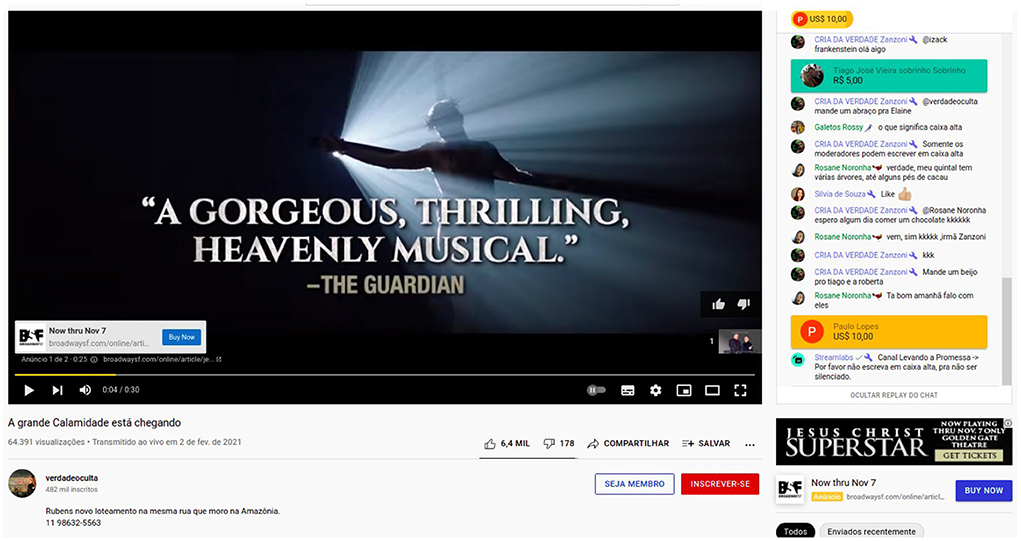
Figure 3. Screenshot of a video from the channel Verdade Oculta streamed in February 2021 and still monetized by YouTube. The video affirms that the COVID-19 pandemic is part of a conspiracy and describes the channels' project to save Brazilians from depopulation. The video description announces the opportunity to buy land near the content creator property.
Channels use tactics to evade content moderation and grow their audience while misinforming about COVID-19
These channels adopted different tactics to disguise, replicate and disperse COVID-19 M&D while evading content moderation, such as content “mirroring” (Allgaier, 2019), “just asking questions” (Lyons et al., 2019), and hand gestures (Table 3). Six channels maintain at least one backup channel—Cidadão-X, Inteligentista, Minha Saúde–Curas Naturais, Pátria Evangélica de Deus, Rômulo Maraschin and Verdade Oculta—, and only 120 videos mention terms like “coronavirus” or “COVID-19” in their titles. The channel Verdade Oculta, for example, advises its interviewees to avoid “forbidden words” and asks them to replace terms such as “vaccine” with “solution.” The same tactic was used in a collaboration between the channels Minha Saúde—Curas Naturais and Palestrante Tiago Rocha: one of the content creators congratulates the channel for its “cleverness” of titling the video “5 foods to boost the immune system,” in order to avoid moderation.
We also found that 18 channels use services such as Whatsapp and Telegram to ensure content circulation, to sell products, or to deliver more extreme materials. From 27 channels spreading COVID-19 M&D in our sample, twelve complain about YouTube's “censorship.” One of the channels, Hidrogênio Global, even tried to create a right-wing social media named “Storm Army” (Figure 4), a reference to the QAnon conspiracy theory. According to the content creator, the platform would ensure fairness and protect freedom of speech since the content would be collectively rated using labels such as “communist,” but without performing content removal.
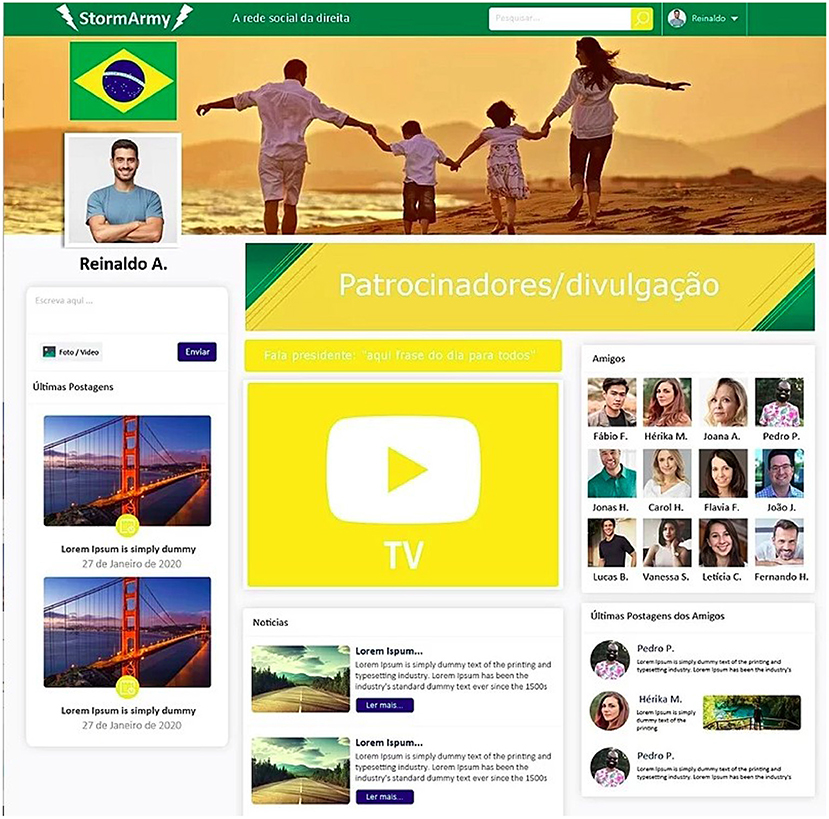
Figure 4. Screenshot of “Storm Army,” a right-wing social media that the channel Hidrogênio Global tried to create through a crowdfunding campaign.
The creators also collaborate between channels to grow their audience or show gratitude. Seventeen channels promoted other channels from the sample (Figure 5) through interviews, praising, or uploading content from each other. Our results show that conspiracy theory and alternative health channels converge through anti-establishment sentiments and conspiracy thinking. In a video from 2018 (Figure 6), the channel Verdade Oculta interviewed the content creator from Dr. Lair Ribeiro Oficial. He congratulated the channel for the courage of presenting “revolutionary ideas” to the audience. They suggested the existence of conspiracies involving “Big Pharma” and promoted the documentary “Forbidden Cures,” that claim to show “what the pharmaceutical industry does not allow the public to know.”
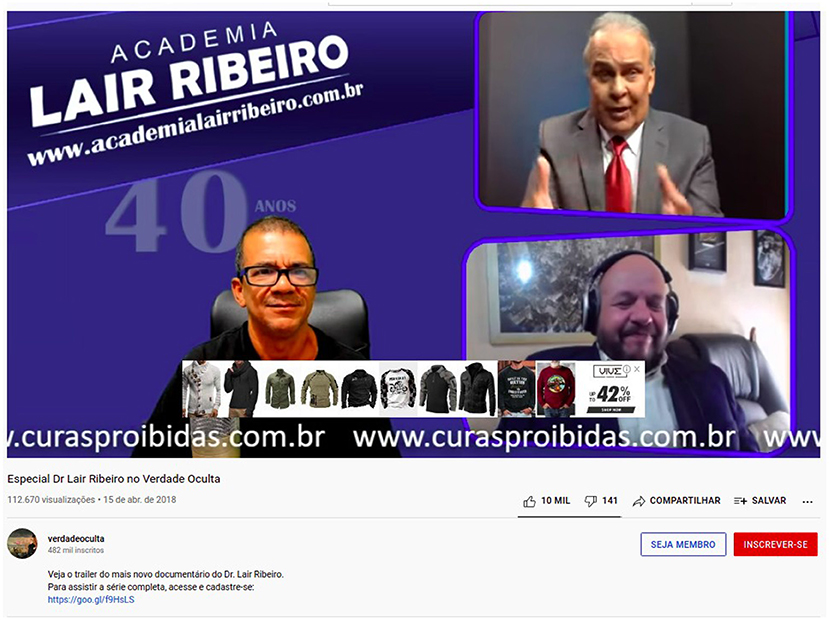
Figure 6. Dr. Lair Ribeiro Oficial's interview on the channel Verdade Oculta. Verdade Oculta was congratulated for the courage of presenting “revolutionary ideas” to the audience, while Dr. Lair Ribeiro Oficial promoted his documentary “Forbidden Cures,” a series of videos that promises to reveal the “truth” about the pharmaceutical industry.
Although YouTube updated its community guidelines during the pandemic, most channels use tactics to keep profiting from COVID-19 M&D
From 719 videos in our sample with COVID-19 M&D, 531 of them were monetized through the YPP. These videos were produced by 24 channels. A total of 516 brands had ads associated with COVID-19 M&D. The advertised brands also included companies that were part of COVID-19 vaccination awareness campaigns, such as Johnson & Johnson, the Centers for Disease Control and Prevention (CDC), and Vaccines.gov (United States Department of Health and Human Services) (Figure 7).
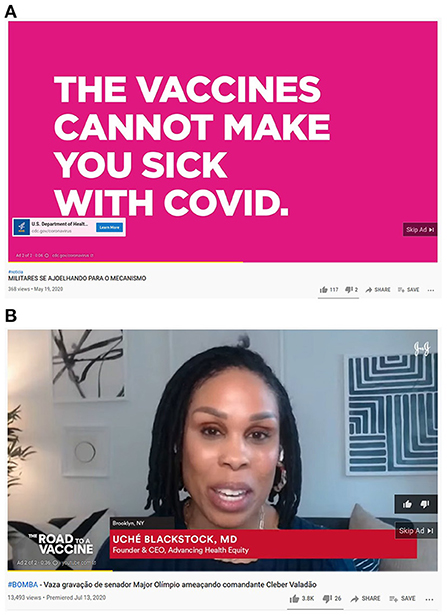
Figure 7. (A,B) Ads from COVID-19 vaccination awareness campaigns from CDC and Johnson & Johnson playing on videos with COVID-19 M&D.
Although YouTube updated its Community Guidelines to address COVID-19 M&D in May 2020 (YouTube Help, 2021a) and in October 2020 (YouTube, 2020; Graham, 2021), 22 channels from our sample were still profiting through the YPP in October 2021. The channel Junior Hallak Medicina e Saúde also had early access to “Super Thanks” (“Valeu demais,” in Brazilian Portuguese). The feature enables the audience to buy an animation to express gratitude for the channel (YouTube Help, 2021b) and is available only for a limited group of content creators (Figure 8).
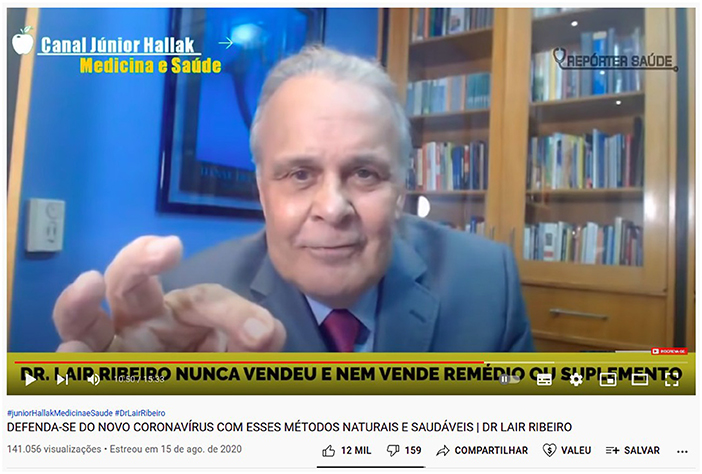
Figure 8. Screenshot of the channel Junior Hallak Medicina e Saúde with the feature “Super Thanks” (“Valeu demais”). The feature is seen as the heart with a dollar sign inside it, and the word “VALEU” on its right. Video title: “Protect yourself from the new Coronavirus with these natural and healthy methods”.
Both channels that lost monetization—Firmeza da Verdade and Rômulo Maraschin—belonged to the same content creator and were removed by YouTube in March 2021. However, in March and April, the creator started three other channels—Canal do Rômulo, Cortes do Rômulo, and Romuland—, uploading the same content, including COVID-19 M&D. In October 2021, these channels were still monetized through ads, and together had more than 102 thousand subscribers. In May 2022, in a last analysis of the videos with M&D we confirmed that 20 channels were still monetized, and that YouTube removed only six from the total of 719 videos containing COVID-19 M&D in our sample.
Fifteen channels went beyond the YPP, adding independent ads, selling products, creating crowdfunding pages, and asking for donations through services such as Paypal and PicPay, or direct deposits in their bank accounts. The channel Nutrição Alimentos & Cia, which creates content to sell naturopathy courses, adapted its videos to address the pandemic anxieties, promoting their courses as opportunities to “not be a slave of the health system.” The channel Verdade Oculta also created an ad system focusing on business owners from the audience (Figure 9).

Figure 9. (A,B) The channels Nutrição Alimentos & Cia and Verdade Oculta showing forms of monetization alternative to YPP. Video titles: “Are our scientists lying to us?”; “The sad ending after all”.
Discussion
During the COVID-19 pandemic, social media platforms frequently updated their policies to respond to COVID-19 M&D (Bailey et al., 2020). Regarding YouTube, in April 2020, the platform stated that it would not allow COVID-19 information contradicting health authorities (Wojcicki, 2020). In May, YouTube updated its Community Guidelines to include a page on COVID-19 M&D (YouTube Help, 2021a), and 5 months later, it expanded their policy to remove videos containing misleading information about COVID-19 vaccines (YouTube, 2020; Graham, 2021).
Despite the announcements, YouTube became a vehicle for COVID-19 M&D since the first months of the pandemic (Ataç et al., 2020; Li et al., 2020; Moon and Lee, 2020). Information contradicting health authorities continued circulating on the platform throughout the public health crisis (Dutta et al., 2020; Ramos et al., 2020; Garcia et al., 2021). The Mozilla Foundation (2021), for instance, analyzed YouTube video recommendations submitted by volunteers from 91 countries from July 2020 to May 2021 and found that COVID-19 M&D was one of the most frequent categories identified.
More than 110 million Brazilians use YouTube monthly (Muratori and Moreschi, 2021), being one of the most popular platforms providing content on science and technology (Massarani et al., 2021). Because of its reach, YouTube also became a space for COVID-19 M&D spreaders in Brazil, such as religious leaders, physicians and politicians (Machado et al., 2020; Moraes and de Silva, 2021).
Brazilian channels often imitate international content creators, repeating the most popular COVID-19 M&D available in English (Brennen et al., 2020). Seven YouTube channels, for instance, praised health misinformation spreaders such as Joseph Mercola, Del Bigtree, David Icke, Alex Jones, Thomas Cowan and Judy Mikovits (Center for Countering Digital Hate, 2020; Gibson, 2020). In addition to social media influencers, the Brazilian government validated different types of COVID-19 M&D during the pandemic. Brazilian President Jair Bolsonaro promoted Hydroxychloroquine and Ivermectin to treat and prevent COVID-19, minimized the pandemic risks, amplified conspiracy theories, and attacked COVID-19 vaccines (Gramacho and Turgeon, 2021; Oliveira et al., 2021; Soares et al., 2021).
Although YouTube says the company enforces its policies globally and has human moderators for content in different languages—including Brazilian Portuguese (Ferreira, 2020)—, President Bolsonaro's amplification of COVID-19 M&D suggests that the enforcement of YouTube policies addressing the pandemic is inconsistent (Duffy, 2022). For example, YouTube Community Guidelines define the concept of a strike: in case of violation of the Community Guidelines, the content creator receives a warning. In the second violation, the channel receives a strike. If a channel receives three strikes in 90 days, it is permanently removed from the platform (YouTube Help, 2022). However, Bolsonaro's channel received five strikes in 1 week of April 2021, and still remained online (G1, 2021). Since then, the channel received other strikes, being only suspended for a week in October 2021, after Bolsonaro suggested that COVID-19 vaccines were associated with AIDS (Feitosa and Salati, 2021; Kochs, 2021).
Besides the enforcement of policies addressing COVID-19 M&D on YouTube, the adaptation of channels to the platform mitigation efforts creates new challenges for content moderation. Tactics to disguise, replicate and disperse M&D (Table 3) impair automatic content moderation and create new obstacles for human reviewers. These adjustments can be a significant challenge for languages other than English, with social media platforms investing less in countering misinformation and delaying action toward harmful content in other countries (Ahmadi, 2021; Valencia, 2021; Duffy, 2022).
The complexity of this problem makes health M&D profitable. As the channels evade content moderation, they can reach larger audiences and fundraise misinformation (Center for Countering Digital Hate, 2020; Skibinski, 2021). For instance, 24 from the 27 channels we identified misinforming about the pandemic were monetized through the YPP. In October 2021, 1 year after the last announcement from the company regarding COVID-19 M&D, 22 channels were still profiting from the YPP.
Our results present a perspective on how the content creators adapted to YouTube's Community Guidelines regarding COVID-19 M&D in Brazil, while these guidelines were being implemented. Spreading misinformation and conspiracy theories during a health crisis can pose significant risks to public health and public trust (Freeman et al., 2020; Loomba et al., 2021). The testimonials conveyed by alternative health channels indicate the potential consequences of misinformation over time. One example from our sample is a person that declares “Every time I need medical help, YouTube is the place I go” in a video from the channel Junior Hallak Medicina e Saúde. This testimonial is given with the information that they replaced their cardiac arrhythmia treatment with a supplement, as advised by Dr. Lair Ribeiro Oficial, another channel from our sample.
More than a technical problem, COVID-19 M&D on YouTube is also a fundamentally social problem: the collaboration between channels will continue to happen even if the platform completely remove its content recommendation algorithms (Lewis, 2018). Therefore, our data suggests that technical measures adopted by YouTube, such as demonetizing specific videos from content creators that repeatedly violate their policies, will not stop COVID-19 M&D from spreading and being financially exploited. Channels from our sample focused on conspiracy theories and alternative health developed tactics to evade content moderation, besides alternative means to profit and deliver misleading content in case of detection.
Social media platforms should adopt more effective measures to counter health M&D. Interventions such as creating a content curation model (Donovan, 2021), strengthening the monitoring of misinformation in languages other than English (OSG, 2021), ensuring accountability of “superspreaders” (Aspen Digital, 2021), and collaborating with key stakeholders to build networked responses to media manipulation campaigns (Donovan et al., 2021) could decrease the reach of online misinformation. Moreover, advertisers should require ad policies that allow companies the choice to stop funding COVID-19 M&D (Center for Countering Digital Hate, 2020; Global Disinformation Index, 2020; Skibinski, 2021).
Limitations and future research
While our data shows the dynamics of specific communities on Brazilian YouTube, it may not describe the phenomenon in other contexts. One has to consider also that our current analysis provides a snapshot of what is happening inside the channels in a specific time interval; this way, future studies comparing tactics to evade content moderation in other countries and languages will be important. These studies could also analyze the dissemination of COVID-19 M&D as the pandemic progresses and channels adapt their tactics accordingly.
Likewise, it would be insightful to examine the dissemination of videos with COVID-19 M&D through other mainstream social media platforms, such as Facebook, Instagram and TikTok. Although in this study we do not analyze the role of YouTube recommendations on the spreading of COVID-19 M&D, this could be an interesting angle for future research. The same approach could be applied for “alt-tech” (Donovan et al., 2019; Rogers, 2020) or “dark platforms” (Zeng and Schäfer, 2021)—Bitchute, Telegram, Gab and others. Future studies could bring relevant information about the cross-platform dynamics of misinformation distribution, contributing to the early detection and mitigation of media manipulation campaigns.
Data availability statement
The original contributions presented in the study are included in the article/supplementary material, further inquiries can be directed to the corresponding author.
Ethics statement
Written informed consent was not obtained from the individual(s) for the publication of any potentially identifiable images or data included in this article.
Author contributions
DT, AF, NR, and LG conceived the study. DT and AF collected the data and wrote the manuscript. DT and NR performed the classification. All authors read and approved the final version of the manuscript.
Funding
This research was partially funded by the Gordon and Betty Moore Foundation through Grant GBMF3834 and by the Alfred P. Sloan Foundation through Grant 2013-10-27 to the University of California, Berkeley.
Conflict of interest
The authors declare that the research was conducted in the absence of any commercial or financial relationships that could be construed as a potential conflict of interest.
Publisher's note
All claims expressed in this article are solely those of the authors and do not necessarily represent those of their affiliated organizations, or those of the publisher, the editors and the reviewers. Any product that may be evaluated in this article, or claim that may be made by its manufacturer, is not guaranteed or endorsed by the publisher.
Supplementary material
The Supplementary Material for this article can be found online at: https://www.frontiersin.org/articles/10.3389/fcomm.2022.1037432/full#supplementary-material
Ahmadi, A, A. (2021). “How anti-Muslim content spreads on YouTube in India,” in First Draft. Available online at: https://firstdraftnews.org/articles/tablighi-jamaat-blamed-for-COVID-19-spread-on-india-youtube (accessed July 1, 2021).
Allgaier, J. (2019). Science and environmental communication on youtube: strategically distorted communications in online videos on climate change and climate engineering. Front. Communicat. 4, 36. doi: 10.3389/fcomm.2019.00036
Aspen Digital (2021). Commission on Information Disorder Final Report. Available online at: https://www.aspeninstitute.org/publications/commission-on-information-disorder-final-report/ (accessed November 20, 2021).
Ataç, O., Özalp, Y.C., Kurnaz, R., Güler, O.M., Inamlik, M., and Hayran, O. (2020). Youtube as an information source during the Coronavirus Disease (COVID-19) pandemic: evaluation of the Turkish and English Content. Cureus. 12, e10795. doi: 10.7759/cureus.10795
Avaaz SBIm (2019). As Fake News estão nos Deixando Doentes? Available online at: https://sbim.org.br/images/files/po-avaaz-relatorio-antivacina.pdf (accessed November 20, 2019).
Bailey, M., Bernstein, O., and Ismail, H. (2020). “The first wave: six months of social media platforms responding to COVID-19,” in Pen America. Available online at: https://pen.org/the-first-wave-social-media-platforms-responding-to-covid-19/ (accessed November 24, 2020)
Bora, K., Das, D., Barman, B., and Borah, P. (2018). Are internet videos useful sources of information during global public health emergencies? A case study of YouTube videos during the 2015–16 Zika virus pandemic. Pathog. Glob. Health 112:6. doi: 10.1080/20477724.2018.1507784
Brennen, J.S., Simon, F.M., Howard, P.N., and Nielsen, R.K. (2020). Types, Sources, and Claims of COVID-19 Misinformation. Oxford: Reuters Institute. Available online at: https://reutersinstitute.politics.ox.ac.uk/types-sources-and-claims-COVID-19-misinformation
Briones, R., Nan, X., Madden, K., and Waks, L. (2012). When vaccines go viral: an analysis of HPV vaccine coverage on YouTube. Health Commun. 27, 5. doi: 10.1080/10410236.2011.610258
Brotas, A.M.P., Costa, M.C.R., Ortiz, J., Santos, C.C., and Massarani, L. (2021). Discurso antivacina no YouTube: A mediação de influenciadores. Revista Eletrônica de Comunicação, Informação e Inovação Em Saúde. 15, 1. doi: 10.29397/reciis.v15i1.2281
Center for Countering Digital Hate (2020). The Anti-Vaxx Industry How Big Tech powers and profits from anti-vaccine misinformation. Available online at: https://www.counterhate.com/anti-vaxx-industry (accessed August 10, 2020).
Charnock, D., Shepperd, S., Needham, G., and Gann, R. (1999). DISCERN: An instrument for judging the quality of written consumer health information on treatment choices. J. Epidemiol. Community Health. 53, 2. doi: 10.1136/jech.53.2.105
Cohen, J. (1960). A coefficient of agreement for nominal scales. Educ. Psychol. Meas. 20, 1. doi: 10.1177/001316446002000104
Donovan, J. (2021). “Shhhh... Combating the Cacophony of Content with Librarians,” in COVID-19 and the Information Space: Boosting the Democratic Response, Dean, J. (eds). p. 33–38. Washington: National Endowment for Democracy. Available online at: https://www.ned.org/global-insights-COVID-19-information-space/
Donovan, J., Friedberg, B, Lim, G., Leaver, N., Nilsen, J., and Dreyfuss, E. (2021). Mitigating Medical Misinformation: A Whole-Of-Society Approach to Spam, Scams, and Hoaxes. Cambridge: Harvard Kennedy School. Available online at: https://mediamanipulation.org/research/mitigating-medical-misinformation-whole-society-approach-countering-spam-scams-and-hoaxes doi: 10.37016/TASC-2021-03
Donovan, J., Lewis, B., and Friedberg, B. (2019). “Parallel Ports: Sociotechnical Change from the Alt-Right to Alt-Tech,” in Post-Digital Cultures of the Far Right: Online Actions and Offline Consequences in Europe and the US Fielitz, M., Thurston, N. Bielefeld: transcript. p. 49–65. doi: 10.1515/9783839446706-004
D'Souza, R.S., D'Souza, S., Strand, N., Anderson, A., Vogt, M.N.P., and Olatoye, O. (2020). YouTube as a source of medical information on the novel coronavirus 2019 disease (COVID-19) pandemic. Glob. Public Health 15, 7. doi: 10.1080/17441692.2020.1761426
Duffy, C. (2022). “More than 80 fact-checking organizations call out YouTube's 'insufficient' response to misinformation.” CNN. Available online at: https://www.cnn.com/2022/01/12/tech/youtube-fact-checkers-letter/index.html (accessed January 12, 2022).
Dutta, A., Beriwal, N., Van Breugel, L.M., Sachdeva, S., Barman, B., Saikia, H., et al. (2020). YouTube as a source of medical and epidemiological information during COVID-19 pandemic: a cross-sectional study of content across six languages around the globe. Cureus. 12, 6. doi: 10.7759/cureus.8622
Feitosa, A. Jr., and Salati, P. (2021). YouTube remove mais 12 vídeos de Bolsonaro por regra que proíbe menção a cloroquina e ivermectina. Available online at: https://g1.globo.com/economia/tecnologia/noticia/2021/05/27/youtube-remove-pelo-menos-11-videos-de-bolsonaro-sobre-cloroquina.ghtml (accessed May 27, 2021).
Ferreira, F. (2020). “Antivaccine videos slip through YouTube's advertising policies, new study finds,” in Science. Available online at: https://www.science.org/content/article/antivaccine-videos-slip-through-youtube-s-advertising-policies-new-study-finds (accessed November 2, 2020).
Freeman, D., Waite, F., Rosebrock, L., Petit, A., Causier, C., East, A., et al. (2020). Coronavirus conspiracy beliefs, mistrust, and compliance with government guidelines in England. Psychol. Med. 52, 251–263. doi: 10.1017/S0033291720001890
G1 (2021). YouTube derruba mais 4 vídeos onde Bolsonaro fala de remédios sem eficácia contra Covid, mas não suspende canal. Available online at: https://g1.globo.com/economia/tecnologia/noticia/2021/04/23/youtube-derruba-mais-4-videos-de-bolsonaro-por-desinformacao-sobre-a-covid.ghtml (accessed April 23, 2021).
Garcia, M., Evangelista Cunha, S., and Oliveira, T. (2021). Regimes de verdade na pandemia de COVID-19: Discursos científicos e desinformativos em disputa no Youtube. Fronteiras - Estudos Midiáticos. 23, 2. doi: 10.4013/fem.2021.232.08
Gibson, K. (2020). “Feds order Alex Jones to stop selling phony coronavirus cures.” CBS News. Available online at: https://www.cbsnews.com/news/alex-jones-infowars-accused-fake-coronavirus-cures-04-10-2020/ (accessed April 10, 2020).
Global Disinformation Index (2020). Ad-funded COVID-19 Disinformation: Money, Brands, and Tech. Available online at: https://disinformationindex.org/wp-content/uploads/2020/07/GDI_Ad-funded-COVID-19-Disinformation-1.pdf (accessed March 25, 2020).
Graham, G. (2021). “How we're supporting COVID-19 vaccine education,” YouTube Official Blog. Available online at: https://blog.youtube/news-and-events/how-were-supporting-COVID-19-vaccine-education/ (accessed March 18, 2021).
Gramacho, W.G., and Turgeon, M. (2021). When politics collides with public health: COVID-19 vaccine country of origin and vaccination acceptance in Brazil. Vaccine. 39, 19. doi: 10.1016/j.vaccine.2021.03.080
Hernández-García, I., and Giménez-Júlvez, T. (2020). Characteristics of YouTube videos in spanish on how to prevent COVID-19. Int. J. Environ. Res. Public Health. 17, 13. doi: 10.3390/ijerph17134671
Jolley, D., and Douglas, K.M. (2014). The effects of anti-vaccine conspiracy theories on vaccination intentions. PLoS ONE. 9, 2. doi: 10.1371/journal.pone.0089177
Kochs, J. (2021). “Brazil's top court opens investigation into Bolsonaro for linking COVID-19 vaccines to AIDS.” CNN. Available online at: https://www.cnn.com/2021/12/04/americas/brazil-bolsonaro-covid-aids-intl-hnk/index.html (accessed December 4, 2021).
Koltai, K.S. (2020). Human Values and Scientific Controversies: Studying Vaccine Information Behavior on Social Networking Sites. [doctoral dissertation]. [Austin (TX)]: University of Texas at Austin.
Lewandowsky, S., Cook, J., Ecker, U. K. H., Albarracín, D., Amazeen, M. A., Kendeou, P. et al. (2020). Debunking Handbook 2020. [s.l.]: Skeptical Science. Available online at: https://sks.to/db2020
Lewandowsky, S., Gignac, G.E., and Oberauer, K. (2013). The role of conspiracist ideation and worldviews in predicting rejection of science. PLoS ONE. 8, 10. doi: 10.1371/journal.pone.0075637
Lewis, R. (2018). Alternative Influence: Broadcasting the Reactionary Right on YouTube. New York: Data & Society. Available online at: https://datasociety.net/library/alternative-influence/
Li, H.O.-Y., Bailey, A., Huynh, D., and Chan, J. (2020). YouTube as a source of information on COVID-19: a pandemic of misinformation? BMJ Global Health 5, 5. doi: 10.1136/bmjgh-2020-002604
Loomba, S., de Figueiredo, A., Piatek, S.J., de Graaf, K., and Larson, H.J. (2021). Measuring the impact of COVID-19 vaccine misinformation on vaccination intent in the UK and USA. Nat. Hum Behav. 5, 3. doi: 10.1038/s41562-021-01056-1
Lyons, B., Merola, V., and Reifler, J. (2019). Not just asking questions: effects of implicit and explicit conspiracy information about vaccines and genetic modification. Health Commun. 34, 14. doi: 10.1080/10410236.2018.1530526
Machado, C.C.V., Dourado, D.A., Santos, J.G., and Santos, N. (2020). Ciência Contaminada: analisando o contágio de desinformação sobre coronavírus via YouTube. Ondina: LAUT, INCT.DD & Cepedisa. Available online at: https://laut.org.br/ciencia-contaminada.pdf
Marchal, N., and Au, H. (2020). “Coronavirus EXPLAINED”: YouTube, COVID-19, and the socio-technical mediation of expertise. Social Media + Society. 6, 3. doi: 10.1177/2056305120948158
Marwah, H.K., Carlson, K., Rosseau, N.A., Chretien, K.C., Kind, T., and Jackson, H.T. (2021). Videos, views, and vaccines: evaluating the quality of COVID-19 communications on YouTube. Disaster Med. Public Health Prep. 1–7. doi: 10.1017/dmp.2021.284
Massarani, L., Castelfranchi, Y., Fagundes, V., and Moreira, I. (2021). “O que os jovens brasileiros pensam da ciência e da tecnologia,” in Manguinhos: INCT-CPCT. Available online at: https://www.inct-cpct.ufpa.br/wp-content/uploads/2021/02/LIVRO_final_web_2pag.pdf
Mazieiro, G. (2021). “De Ana Hickmann a Otávio Mesquita: celebridades receberam R$ 4,3 milhões para fazer propaganda para Bolsonaro,” in The Intercept Brasil. Available online at: https://theintercept.com/2021/08/11/de-ana-hickmann-a-otavio-mesquita-celebridades-receberam-r-43-milhoes-para-fazer-propaganda-para-bolsonaro (accessed August 11, 2021).
Moon, H., and Lee, G.H. (2020). Evaluation of Korean-language COVID-19–related medical information on YouTube: cross-sectional infodemiology study. J. Med. Internet Res. 22, 8. doi: 10.2196/20775
Moraes, A.S., and de Silva, D.P. (2021). A pandemia nas lives semanais: O uso de atenuadores na retórica anticrise de Jair Bolsonaro. Topoi. 22, 48. doi: 10.1590/2237-101x02204806
Mozilla Foundation (2021). YouTube Regrets. A crowdsourced investigation into YouTube's recommendation algorithm. Available online at: https://assets.mofoprod.net/network/documents/Mozilla_YouTube_Regrets_Report.pdf (accessed August 22, 2021).
Muratori, P., and Moreschi, S. (2021). “Pesquisa inédita mostra o impacto econômico, cultural e social do YouTube no Brasil,” Think with Google. Available online at: https://www.thinkwithgoogle.com/intl/pt-br/estrategias-de-marketing/video/impacto-economico-cultural-social-youtube-brasil/ (accessed October, 2021)
Oliveira, T., Evangelista, S., Alves, M., and Quinan, R. (2021). “Those on the Right Take Chloroquine”: The Illiberal Instrumentalisation of Scientific Debates during the COVID-19 Pandemic in Brasil. Javnost - The Public. 28, 2. doi: 10.1080/13183222.2021.1921521
OSG (2021). Confronting Health Misinformation: The U.S. Surgeon General's Advisory on Building a Healthy Information Environment. US Department of Health and Human Services. Available online at: https://www.hhs.gov/sites/default/files/surgeon-general-misinformation-advisory.pdf [(accessed July 20, 2021).
Pandey, A., Patni, N., Singh, M., Sood, A., and Singh, G. (2010). YouTube as a source of information on the H1N1 influenza pandemic. Am. J. Prev. Med. 38, 3. doi: 10.1016/j.amepre.2009.11.007
Paraguassu, L. (2020). “Brazil Health Ministry confirms first coronavirus case in Latin America.” CNBC. Available online at: https://www.cnbc.com/2020/02/26/brazil-health-ministry-confirms-first-coronavirus-case-in-latin-america.html (accessed February 26, 2020).
Pathak, R., Poudel, D., Karmacharya, P., Pathak, A., Mahmood, M., Aryal, M., et al. (2015). Youtube as a source of information on Ebola virus disease. N. Am. J. Med. Sci. 7, 7. doi: 10.4103/1947-2714.161244
Pettersson, H., Manley, B., and Hernandez, S. (2022). “Tracking COVID-19's global spread.” CNN. Available online at: https://www.cnn.com/interactive/2020/health/coronavirus-maps-and-cases/ (accessed August 9, 2022).
Ramos, T.B., Bokehi, L.C., Bokehi, R.C., Pinheiro, T.S., Oliveira, E.B., Torres, R.S.G., et al. (2020). YouTube as a source of information on chloroquine and hydroxychloroquine during the COVID-19 pandemic. J. Sci. Communicat. 19, 07. doi: 10.22323/2.19070206
Rieder, B. (2015). YouTube Data Tools (Version 1.22). Available online at: https://tools.digitalmethods.net/netvizz/youtube/ (accessed September 5, 2020).
Rogers, R. (2020). Deplatforming: Following extreme Internet celebrities to Telegram and alternative social media. Eur. J. Communicat. 35, 3. doi: 10.1177/0267323120922066
RSF (2020). “Brazil quarterly analysis. President Bolsonaro's systematic attempts to reduce the media to silence,” in Reporters without Borders. Available online at: https://rsf.org/en/news/brazil-quarterly-analysis-president-bolsonaros-systematic-attempts-reduce-media-silence (accessed April 16, 2020).
Silberg, W.M. (1997). Assessing, controlling, and assuring the quality of medical information on the internet: caveant lector et viewor — let the reader and viewer beware. JAMA. 277, 15. doi: 10.1001/jama.1997.03540390074039
Skibinski, M. (2021). “Thousands of the world's most trusted brands funded COVID-19 misinformation,” NewsGuard. Available online at: https://www.newsguardtech.com/special-reports/special-report-advertising-on-covid-19-misinformation/ (accessed December 3, 2021).
Soares, F. B., Recuero, R., Volcan, T., Fagundes, G., and Sodré, G. (2021). Research note: Bolsonaro's firehose: how COVID-19 disinformation on WhatsApp was used to fight a government political crisis in Brazil. Harvard Kennedy School Misinformation Rev. 2, 1–13. doi: 10.37016/mr-2020-54
Stewart, C.J. (2002). The master conspiracy of the john birch society: from communism to the new world order. West. J. Commun. 66, 4. doi: 10.1080/10570310209374748
Tokojima Machado, D. F., de Siqueira, A. F., and Gitahy, L. (2020). Natural Stings: Selling Distrust About Vaccines on Brazilian YouTube. Frontiers in Communication 5:577941. doi: 10.3389/fcomm.2020.577941
Valencia, S. (2021). “Misinformation online is bad in English. But it's far worse in Spanish,” Washington Post. Available online at: https://www.washingtonpost.com/outlook/2021/10/28/misinformation-spanish-facebook-social-media/ (accessed October 28, 2021).
Venkatraman, A., Garg, N., and Kumar, N. (2015). Greater freedom of speech on Web 2.0 correlates with dominance of views linking vaccines to autism. Vaccine. 33, 12. doi: 10.1016/j.vaccine.2015.01.078
Vraga, E. K., and Bode, L. (2020). Defining misinformation and understanding its bounded nature: using expertise and evidence for describing misinformation. Polit. Commun. 37, 1. doi: 10.1080/10584609.2020.1716500
Wojcicki, S. (2020). Inside YouTube's 'numerous policy changes' during the pandemic. Interview by Brian Stelter. Reliable Sources, CNN. Video, 00:38. Available online at: https://edition.cnn.com/videos/business/2020/04/19/inside-youtubes-numerous-policy-changes-during-the-pandemic.cnn (accessed October 06, 2022).
World Health Organization (2021). WHO Public Health Research Agenda for Managing Infodemics. Available online at: https://www.who.int/publications/i/item/9789240019508 (accessed April 20, 2021).
YouTube (2020). How YouTube is Helping People Get the Facts on the COVID-19 Vaccine. Available online at: https://kstatic.googleusercontent.com/files/cff728370bf80417871d42ec5eadcb9c2c b2bfeaf8fd41608592a2552b6254501589c367b26b8511c634e16f6fcd99e3036b5827 cb849a858c08a2d3125de8f7 (accessed October 06, 2022).
YouTube Help (2021a). Coronavirus disease 2019 (COVID-19) updates. Available online at: https://support.google.com/youtube/answer/9777243 (accessed April 27, 2021).
YouTube Help (2021b). Turn on and manage Super Thanks. Available online at: https://support.google.com/youtube/answer/10878910?hl=en&ref_topic=9154079 (accessed August 9, 2022).
YouTube Help (2022). Community Guidelines strike basics on YouTube. Available online at: https://support.google.com/youtube/answer/2802032 (accessed August 29, 2022).
Keywords: COVID-19, vaccine, misinformation, YouTube, content moderation, social media
Citation: Tokojima Machado DF, Fioravante de Siqueira A, Rallo Shimizu N and Gitahy L (2022) It-which-must-not-be-named: COVID-19 misinformation, tactics to profit from it and to evade content moderation on YouTube. Front. Commun. 7:1037432. doi: 10.3389/fcomm.2022.1037432
Received: 05 September 2022; Accepted: 12 October 2022;
Published: 03 November 2022.
Edited by:
Andrea M. Feldpausch-Parker, SUNY College of Environmental Science and Forestry, United StatesReviewed by:
Anke Van Kempen, Munich University of Applied Sciences, GermanyTendai Chari, University of Venda, South Africa
Copyright © 2022 Tokojima Machado, Fioravante de Siqueira, Rallo Shimizu and Gitahy. This is an open-access article distributed under the terms of the Creative Commons Attribution License (CC BY). The use, distribution or reproduction in other forums is permitted, provided the original author(s) and the copyright owner(s) are credited and that the original publication in this journal is cited, in accordance with accepted academic practice. No use, distribution or reproduction is permitted which does not comply with these terms.
*Correspondence: Dayane Fumiyo Tokojima Machado, ZGF5YW5lLm1hY2hhZG9AaWdkb3JlLm9yZw==
 Dayane Fumiyo Tokojima Machado
Dayane Fumiyo Tokojima Machado Alexandre Fioravante de Siqueira
Alexandre Fioravante de Siqueira Natiely Rallo Shimizu1
Natiely Rallo Shimizu1 Leda Gitahy
Leda Gitahy